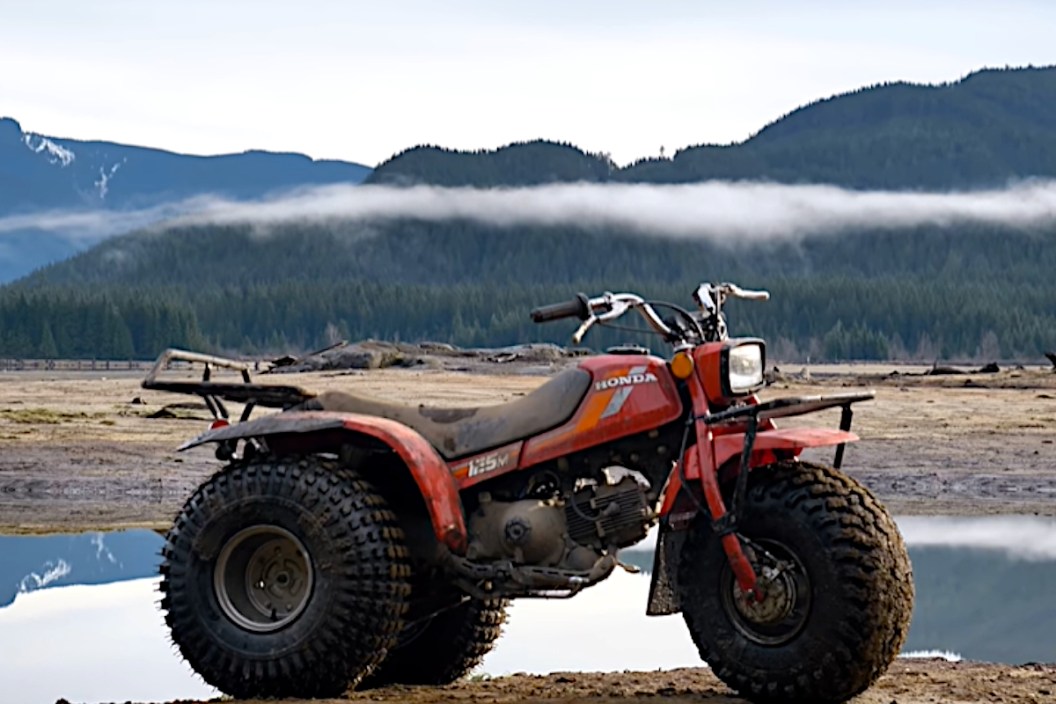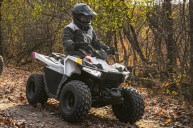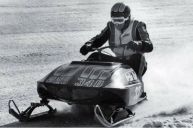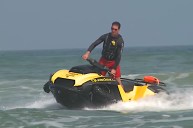Whatever happened to the three wheeler ATV?
Back in the mid-1980s, my father started saving and stashing some money away because he wanted a new toy. My mother was less than thrilled when she found the stash and discovered he'd been saving up for a specific purpose. He ended up buying it anyway. A 1986 Honda Big Red three-wheel ATV. He'd keep that off-road vehicle for more than 20 years before selling it. Still with the factory wheels on it. It still looked showroom new when he said good-bye to it.
I hadn't thought much about the three wheelers in a long time. Fast forward over 30 years later to last September. I was in Stillwater, Minnesota for a Polaris press event checking out and test driving their 2021 off-road vehicle line of four-wheel ATVS and UTVS. During a break, Polaris President Steve Menneto joked to us that one of the other journalists in attendance had been begging him for years to "bring back the three-wheeler."
It made me pause a second. Why weren't ATV manufacturers still making three-wheelers? I recalled my dad saying they were banned due to ATV safety concerns, but that almost sounded like an urban legend to me. Was it really true? Had the government really cracked down that hard on this all-terrain vehicle? Intrigued, I decided to do a little research and find out for myself.
The evolution of the three-wheeler.
You must go back to the late 1960s, early 1970s when looking at the history of the three-wheeler. It seems the first real three-wheeler was the sit-in Sperry-Rand Tricart. If you've never heard of it, we're not surprised. It's rather crude-looking as far as ATV designs go, looking more like an oversized children's toy than a practical off-road vehicle.
According to ATV Connection, this first trike was powered by a five-horsepower lawnmower engine. We can't speak without having sat on one, but it doesn't look comfortable as the foot pegs are forward and the ATV rider has a low center of gravity on the frame while driving. In any case, they produced and sold as many as 40,000 of these things, but they were quickly overshadowed by what the Japanese were cooking up in their development centers.
In 1970, Honda took the powersports world by storm with the introduction of the "all-terrain cycle" or ATC for short. The ATC90s were powered by an 89cc engine pumping out only about seven ponies of horsepower. Many companies build youth ATVs more powerful than that these days. These early three-wheelers have a solid rear axle and no suspension system at all. On paper, it feels like this vehicle should have been a total failure.
However, as this video from YouTuber FortNine notes, the oversized tires give the vehicle the ability to handle everything from mud, snow, rocks and even standing water with ease. It gave it more functionality than a snowmobile and immediately appealed to people looking for a vehicle for work. It helps that they're insanely fun to drive too. All the neighborhood kids were sure to be jealous of the family that just got a brand-new ATC. As ATV Course notes, the 1973 oil crisis may have played a part in the rise of the three-wheeler too. Gas rationing or not, there was still work that needed to be done on many farms and the little ATCs were much more fuel efficient than the other machines in the barnyard.
There were a few other factors helping drive the three-wheeler's success. One was the low $600 price tag. The vehicle was also made cool by the likes Sean Connery when the ATC appeared in the James Bond film "Diamonds are Forever." In a way it harkens back to the gigantic success of the Smith & Wesson Model 29 revolver after Clint Eastwood wielded one in the "Dirty Harry" movies. The ATC also made appearances on "Magnum P.I." and "Hart to Hart" on TV, further cementing the "cool factor" of these little ATVs. We're not sure if that was planned product placement on Honda's part, or if TV and movie studios just thought the vehicles fit the scenes they needed. Either way, ATCs were cool, and many people wanted one.
The Three-Wheeler becomes an 80's staple.
Honda produced ATC90 and ATC70 variants throughout the 1970s and they continued to sell well. Most of these machines were air-cooled, 4-strokes. In 1979, they finally upgraded the engine size to 105ccs in the ATC 110. Two years later, in 1981, they introduced the now-iconic Honda ATC 250R. The new machine was a speed demon thanks to a 248cc, two stroke engine. The first models of the ATC250R were air-cooled, but they soon moved to a liquid-cooled model. These speedy three-wheelers also had a suspension to finally tame some of those bumps that ATC owners had been dealing with for the better part of a decade.
Of course, imitation is the sincerest form of flattery and it didn't take long for other companies to take notice of what Honda was doing. Around this same time, the competition was starting to get into the three-wheeler market with dirt bike companies like Kawasaki, Suzuki and Yamaha all producing their own versions of off-road trike. Racers took notice of the power and speed of these machines. It wasn't long before ATV racing was becoming as popular as motocross.
Still, Honda remained king with vehicles like the ATC200X and the ATC250R becoming classics. The Big Red my father owned was formally introduced as a utility model in 1982. The 1986 model he owned had a 250cc motor with electric start. That machine ended up being a huge part of my childhood. For the record, I only flipped it once that I can recall! It is worth noting that it does take some skill and experience to operate one of these machines properly. That may not have been clear to many people who bought them and it led to a difficult time for the ATV industry.
Were three-wheelers banned?
By the mid-1980s, people had started to notice that three-wheelers were slightly more prone to tipping than their four-wheeled cousins which had just begun to hit the market. However, the federal Consumer Product Safety Commission or CPSC, had noticed the accidents involving the machines, particularly the ones involving younger riders, which made up the bulk of the accidents. Studies were commissioned and bad press like the 60 minutes report above soon followed and the ATV industry was put in a difficult spot.
Before we go further, one could say the three-wheeler made an easy target in the 1980s. After all, this was the time of the great "satanic panic" in which many parents were tossing away their kid's rock and roll albums, dungeons and dragons board games and comic books under the ridiculous assumption they were "evil." We laugh about it now, but there was a lot of: "Won't somebody please think of the children?" going on back then.
It's also no coincidence ATV accidents involving young riders were on the rise, the sport of ATV riding itself was exploding to numbers never seen before. What did they expect was going to happen? It's funny to read that the CPSC's own studies showed most of those accidents were due improper use of the machines and not as a result of the three-wheeler's unique design. Color us surprised on that one.
However, it didn't really matter what the studies showed. Angry parents of injured children, lawsuits, recall threats and the CPSC were hanging over the ATV industry like the sword of Damocles. To the point the industry became worried legislation enforcing a ban would eventually be drafted anyway. They were already getting a lot of bad press on the machines and congressional hearings would likely worsen things. The CPSC had a compromise ready and the big manufacturers of three wheelers took it.
In April of 1988, they signed what became known as the "Final Consent Decree." Basically, it stated that there would be a 10-year moratorium on three-wheeler sales, development and the importation of the machines. All the manufacturers also agreed to pump a whopping $100 million into ATV safety education, which probably would have been a good idea even if the machines weren't banned.
That was that, some of the last three-wheelers rolled off assembly lines in 1987 and they were never produced again. So, technically, the government didn't "ban three-wheelers." The ATV manufacturers themselves did that for them. Of course, this begs a big question.
Why haven't three-wheelers made a comeback?
It was around 1982 when Suzuki introduced the QuadRunner LT125, one of the first four-wheelers that built off some of the technologies that had been pioneered with the three-wheelers. By the mid-1980s, all the major companies had either produced or were working on their own concepts for quads. Honda introduced their first vehicle, the FourTrax TRX250R in 1984 and the first four-wheeler with four-wheel drive two years later in 1986. These machines proved to be as popular, if not more, than the three-wheeler ever was. Because the four-wheelers were more stable, it seems it was easier for them to stave off attacks from the critics.
Since then, four-wheelers have become a huge, multi-billion-dollar industry with more manufacturers than ever before putting out their own versions of the machines. Honda, Kawasaki, Yamaha and Suzuki remain four of the big names in the industry today. The death of the three-wheeler didn't do much to stifle their growth.
Now, of course, that moratorium on the building and importation of new three-wheelers expired a long time ago, so why haven't they mounted a comeback? We don't really have an answer for that other than the powersports industry may not need them. Especially since the introduction of the UTV back in the late 1990s.
During my trip to the Polaris facilities, all the engineers, tech people and PR reps for the company told me repeatedly 2020 was their busiest and biggest year ever for sales. Some of the growth was spurred by more people taking up riding as a hobby due to the Covid-19 pandemic, but you could also argue that's the way the powersports industry continues to trend regardless.
It also wouldn't surprise me if a new three-wheeler is simply a can of worms no company is willing to open just yet given the history of the machine.
However, never say never. Throw-back products are huge now in almost every industry. It wouldn't surprise us at all to see a major manufacturer bring them back, even if only for a limited time to tap into that nostalgia. At the very least, we'd love to see it and for the chance to get behind the handlebars of a three-wheeler at least one more time.
For more outdoor content from Travis Smola, be sure to follow him on Twitter and check out his Geocaching and Outdoors with Travis YouTube channels.
NEXT: THE AXIS DEER AND HOW THEY'RE IMPACTING PARTS OF THE UNITED STATES
WATCH





